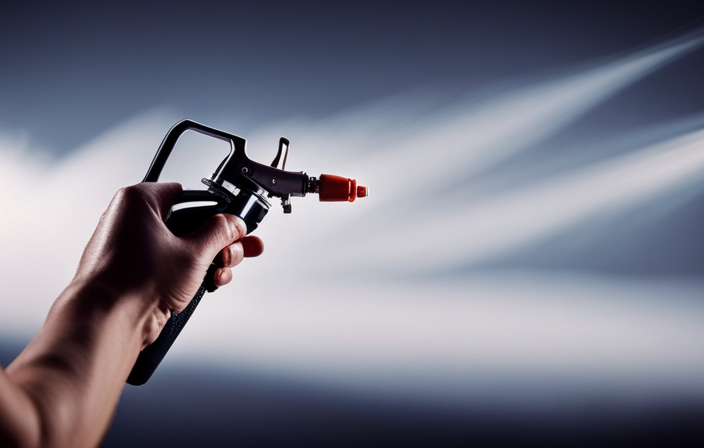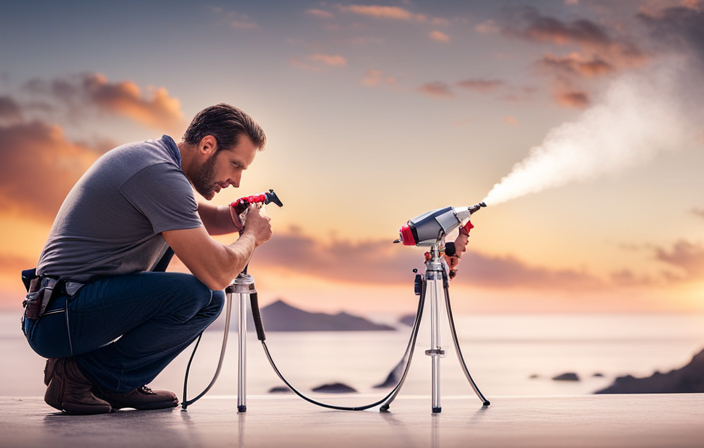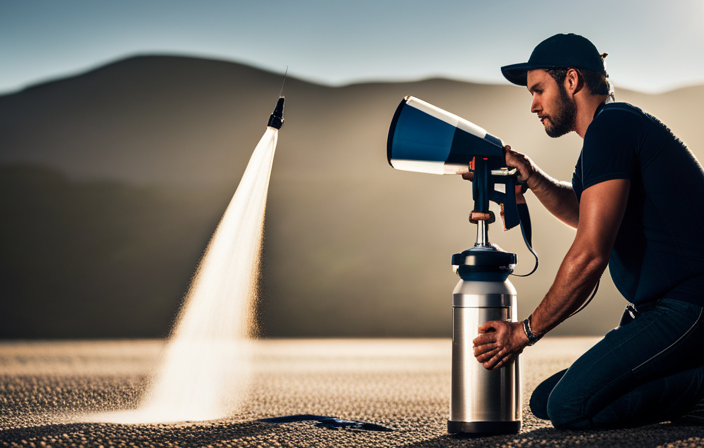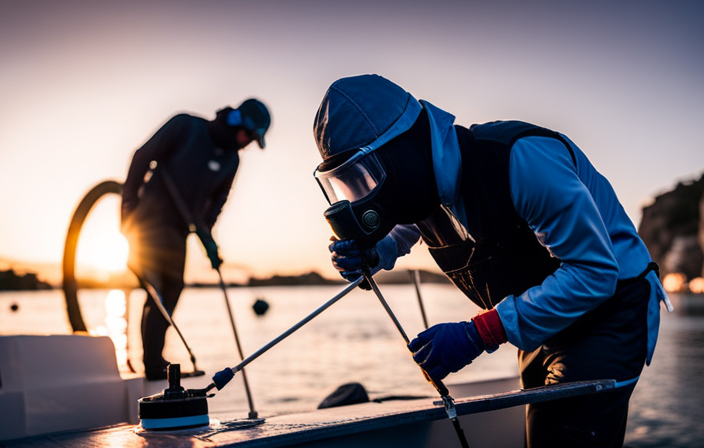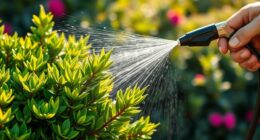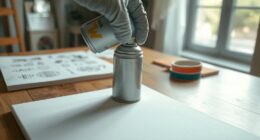Have you ever wanted to give the inside of your home a fresh coat of paint but dreaded the mess caused by overspray? Look no further! This article will guide you on how to use an airless sprayer to paint the interior of your home while minimizing overspray.
First things first, it is important to properly prepare your painting area. This includes covering furniture and flooring, as well as taping off any areas you do not want to paint. Once your area is prepped, it’s time to choose the right paint and equipment.
Next, you’ll want to practice proper spraying technique to ensure an even coat. Adjusting the sprayer settings is crucial for controlling the amount of paint being released. Starting with a primer coat is also recommended to achieve a smooth finish.
Lastly, always remember to clean the sprayer properly after use and protect yourself and your surroundings. And don’t forget, patience is key! Take breaks when needed to maintain focus and precision.
So, let’s get started on transforming your interiors with an airless sprayer, without the worry of overspray!
Key Takeaways
- Thoroughly prepare the surface and use a primer to achieve a flawless end result.
- Apply paint in thin, even coats to achieve a smooth and even finish.
- Use a smaller tip or brush attachment to control overspray, especially in corners and edges.
- Practice patience, precision, and proper cleaning techniques for professional results and a safe painting environment.
Prepare your painting area
Get ready to transform your space by prepping the painting area with these easy steps! Before you start spraying, it is crucial to prepare your surfaces properly.
- Clean the walls thoroughly to remove any dirt or grease that could affect the paint’s adhesion.
- Repair any cracks or holes and sand them smooth.
Next, cover floors, furniture, and fixtures with plastic drop cloths to protect them from overspray. Use painter’s tape to mask off areas that you don’t want to be painted.
Now that your surfaces are prepped, it’s time to choose the right paint and equipment.
- Select high-quality paint that is suitable for your interior walls and consider the color scheme you desire.
- Additionally, invest in a good airless sprayer that will provide a fine finish without excessive overspray.
Choose the right paint and equipment
Make sure you’ve got the correct type of paint and the right equipment to achieve a flawless finish when you’re tackling your interior project with an airless sprayer; it’s like finding the missing piece of the puzzle for a picture-perfect result. When it comes to painting techniques, using the right paint and equipment is crucial. The table below provides a comparison of different types of paint and their characteristics, as well as the recommended equipment for each type:
| Paint Type | Characteristics | Recommended Equipment |
|---|---|---|
| Latex | Water-based | Airless sprayer |
| Oil-based | Durable | Airless sprayer |
| Enamel | Glossy finish | Airless sprayer |
Safety precautions are also important when using an airless sprayer. Always wear protective clothing, including goggles and a respirator, to prevent any paint from getting on your skin or in your eyes. Additionally, make sure to ventilate the area properly to avoid inhaling any fumes. Practice proper spraying technique is essential to prevent overspray and achieve an even coat.
Practice proper spraying technique
Mastering the art of proper spraying technique is the key to achieving a flawlessly smooth finish that will leave you feeling accomplished and proud of your painting project. To improve spraying efficiency and minimize paint wastage, there are a few techniques to keep in mind.
First, maintain a consistent distance of around 12 inches from the surface you are painting. This will ensure an even application without excessive overspray.
Additionally, move your arm in a fluid motion, keeping it parallel to the surface. Avoid stopping or hesitating in one spot, as this can result in uneven coverage.
Finally, overlap each pass by about 50% to ensure complete coverage. By practicing these techniques, you will be able to achieve professional-quality results.
Now, let’s move on to adjusting the sprayer settings.
Adjust the sprayer settings
Before starting to paint with an airless sprayer, it’s important to adjust the pressure and flow rate for optimal results. This will ensure that the paint is evenly distributed and there’s no over spray.
I always recommend testing the spray pattern on a scrap surface before starting the actual painting. This allows me to make any necessary adjustments and ensures a smooth and professional finish.
Adjust the pressure and flow rate for optimal results
Achieving flawless results with your airless sprayer is as simple as adjusting the pressure and flow rate just right. Properly adjusting the pressure ensures that the paint atomizes correctly, while maintaining the flow rate ensures a consistent application. To adjust the pressure, refer to the manufacturer’s guidelines and gradually increase or decrease it until you achieve the desired result. Similarly, adjusting the flow rate will depend on the type of paint used and the surface being painted. A higher flow rate may be needed for thicker paints or larger surfaces, while a lower flow rate may be necessary for more delicate work. By finding the perfect balance between pressure and flow rate, you can minimize overspray and achieve a professional finish. Now that you have the pressure and flow rate adjusted, it’s time to test the spray pattern on a scrap surface before starting the actual painting process.
Test the spray pattern on a scrap surface before starting
To ensure a flawless finish, it is important to test the spray pattern on a scrap surface before beginning. This allows you to adjust any settings if needed. Here are some testing techniques and troubleshooting tips to help you achieve the best results:
-
Distance: Hold the sprayer at a consistent distance from the surface, usually around 12-18 inches. This ensures an even spray pattern.
-
Overlap: Keep a consistent overlap of about 50% between each pass. This helps to avoid uneven coverage.
-
Speed: Move the sprayer at a steady speed. This maintains a consistent spray pattern and prevents over spray.
By testing the spray pattern on a scrap surface, you can identify any issues and make necessary adjustments before starting the actual painting process. Once you are satisfied with the results, you can confidently proceed with applying the primer coat.
Start with a primer coat
When painting interiors with an airless sprayer, it’s essential to start with a primer coat. Applying a primer helps create a smooth and even base for the paint, ensuring better adhesion and durability.
It’s crucial to allow the primer to dry thoroughly before proceeding with the paint application. This will help achieve a flawless finish.
Apply a primer to create a smooth base for the paint
To create a smooth base for the paint, start by preparing the surface with a primer. This will ensure a flawless foundation for the paint when using an airless sprayer.
To achieve a smooth surface and promote paint adhesion, follow these steps:
-
Clean the surface: Remove any dirt, grease, or loose paint using a mild detergent and a scrub brush.
-
Repair imperfections: Fill in any holes, cracks, or dents with a suitable filler and sand the surface smooth.
-
Protect adjacent areas: Use painter’s tape and plastic sheeting to cover areas that you don’t want to paint.
-
Apply the primer: Using an airless sprayer, apply a thin and even coat of primer to the surface, working in overlapping passes.
-
Allow the primer to dry thoroughly before painting: This will ensure proper bonding and a professional finish.
Once the primer has dried, you’re ready to move on to the next step of painting the interior with an airless sprayer without over spray.
Allow the primer to dry thoroughly before painting
Make sure you give the primer enough time to dry thoroughly before you move on to the exciting part of transforming your space with a fresh coat of vibrant color. Proper ventilation is crucial during the drying process to ensure the primer cures properly and creates a strong bond with the surface. Open windows or use fans to circulate air and help expedite the drying time.
Once the primer is dry, it’s important to properly sand and prepare the primed surface before painting. Use a fine-grit sandpaper to smooth out any imperfections and create a smooth base for the paint. Wipe away any dust or debris with a clean cloth before you begin painting.
By allowing the primer to dry thoroughly and preparing the surface properly, you ensure a flawless end result. Now, let’s move on to the next step of applying the paint in thin, even coats.
Apply the paint in thin, even coats
To achieve a flawless finish, it’s crucial to apply the paint in thin, even coats using an airless sprayer. This method allows for better control over paint application and helps to avoid overspray. By using an airless sprayer, you can achieve a smooth and even coat of paint on your interior surfaces.
To further enhance your painting skills, consider the following tips:
-
Adjust the pressure: Set the airless sprayer to a lower pressure to minimize overspray and achieve better control.
-
Maintain the right distance: Keep the sprayer nozzle approximately 12-18 inches away from the surface being painted to ensure an even application.
-
Overlap strokes: In a systematic and organized manner, overlap each stroke by about 50% to avoid leaving gaps or streaks.
-
Practice on a test surface: Before starting on the actual walls, practice your technique on a scrap piece of material to get a feel for the sprayer and adjust your settings if needed.
By following these guidelines, you can achieve professional-looking results without the worry of overspray. Next, let’s discuss how to pay attention to corners and edges for a seamless finish.
Pay attention to corners and edges
When it comes to painting corners and edges, I find it helpful to use a smaller tip or brush attachment for more precise painting. This allows me to have better control and avoid any accidental smudges or overlaps.
Additionally, I make sure to take my time in these tight areas, ensuring thorough coverage and a seamless finish.
Use a smaller tip or brush attachment for precise painting
For a more precise painting experience, grab a smaller tip or brush attachment for your airless sprayer. Using a smaller tip can reduce overspray by up to 50%. Precision painting techniques are essential for professional-looking results.
Airless sprayers offer many advantages but can create overspray if not used correctly. By using a smaller tip or brush attachment, you can have more control over the paint flow and target specific areas with accuracy. This is especially useful for corners and edges where overspray is more likely to occur.
Taking the time to ensure thorough coverage in tight areas is crucial for a flawless finish. So, let’s move on to the next section and learn how to take your time and achieve the best results in those hard-to-reach spots.
Take your time to ensure thorough coverage in tight areas
When using an airless sprayer to paint interiors, it is essential to take your time and employ thorough coverage techniques to avoid paint buildup in tight areas. Start by using a smaller tip or brush attachment for better precision. This allows you to reach into corners and edges without worrying about excessive overspray.
Move the sprayer in a controlled manner, ensuring that each area receives an even coat of paint. Pay close attention to hard-to-reach spots, such as behind furniture or around light fixtures. By being meticulous in your approach, you can achieve a professional-looking result without any unsightly buildup.
Once you have completed the painting process, it is crucial to clean the sprayer properly to maintain its performance and longevity.
Clean the sprayer properly after use
To ensure a flawless finish, make sure you clean the sprayer thoroughly after each use, so that you can avoid any potential over spray issues. Proper cleaning techniques and maintenance tips are essential for the longevity of your airless sprayer and to ensure it performs at its best. Here are some steps you can follow to clean your sprayer effectively:
| Step | Cleaning Task |
|---|---|
| 1 | Disconnect the sprayer from the power source and relieve any built-up pressure. |
| 2 | Remove the spray tip, filter, and guard, and clean them with warm, soapy water. |
| 3 | Flush the sprayer with a cleaning solution recommended by the manufacturer. |
| 4 | Use a brush or cloth to remove any paint residue from the sprayer’s components. |
| 5 | Rinse the sprayer thoroughly with clean water and reassemble all the parts. |
By following these cleaning techniques and maintenance tips, you can ensure your sprayer remains in optimal condition, allowing you to achieve professional results without over spray. Now, let’s move on to the next section on how to protect yourself and your surroundings.
Protect yourself and your surroundings
To protect yourself and your surroundings while using the sprayer, it is important to take the necessary precautions. First and foremost, wear the appropriate protective clothing, such as goggles, gloves, and a respirator mask. These items will shield you from any potential harm.
Additionally, ensure that the area you are working in has proper ventilation. This will help minimize the inhalation of fumes. You can achieve this by opening windows and doors or using fans to circulate fresh air.
It is also crucial to cover nearby furniture, floors, and fixtures with drop cloths or plastic sheets. This will prevent any accidental overspray and protect your belongings.
By taking these measures, you can create a safe and controlled environment for your painting project. Remember to practice patience and take breaks when needed to maintain a steady hand and a focused mind throughout the process.
Practice patience and take breaks
After taking the necessary precautions to protect myself and my surroundings, I have learned that practicing patience and taking breaks during the process of painting interiors with an airless sprayer is crucial.
Not only does this allow me to maintain my focus and precision, but it also helps me avoid over spray.
Patience benefits me in several ways. It allows me to carefully control the spray pattern and pressure, ensuring an even coat without wastage or splatters.
By taking breaks, I can step back and assess the progress, making any necessary adjustments before continuing. This methodical approach reduces the risk of over spray and ensures a smooth, professional finish.
So, even though it may be tempting to rush through the job, I remind myself that patience truly pays off in the end.
Frequently Asked Questions
What are the potential risks or hazards of using an airless sprayer?
The potential risks and hazards of using an airless sprayer include exposure to toxic fumes, eye and skin irritation, and the risk of injury due to high pressure. Proper safety precautions and protective gear should always be used.
Can an airless sprayer be used for both interior and exterior painting projects?
Yes, an airless sprayer can be used for both interior and exterior painting projects. It offers several benefits for interior projects, such as faster application, even coverage, and the ability to handle a variety of coatings.
Are there any specific safety precautions that need to be taken when using an airless sprayer?
When using an airless sprayer, it is important to take specific safety precautions to avoid over spray. This includes wearing protective clothing, using a respirator, and ensuring proper ventilation in the workspace.
How do you properly clean and maintain an airless sprayer to ensure its longevity?
To clean and maintain an airless sprayer, I recommend thoroughly flushing the system with water or cleaning solution after each use. Regularly inspect and replace worn parts, and store the sprayer in a clean, dry place. Proper maintenance ensures longevity.
What are some common mistakes to avoid when using an airless sprayer for interior painting?
When using an airless sprayer for interior painting, it’s crucial to avoid common mistakes that can lead to overspray. Proper technique, adjusting pressure, and using the right nozzle size are key to achieving a clean and precise finish.
Conclusion
In conclusion, painting interiors with an airless sprayer requires careful preparation, the right equipment, and a steady hand.
By adjusting the sprayer settings and practicing proper technique, you can achieve a flawless finish without any overspray.
Remember to pay attention to corners and edges, as they can be easily missed.
Cleaning the sprayer thoroughly after use is essential for its longevity.
Lastly, protect yourself and your surroundings, and don’t forget to practice patience and take breaks when needed.
As the saying goes, ‘Rome wasn’t built in a day,’ and neither is a perfectly painted interior.

